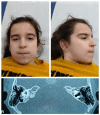The Arg99Gln Substitution in HNRNPC Is Associated with a Distinctive Clinical Phenotype Characterized by Facial Dysmorphism and Ocular and Cochlear Anomalies
- PMID: 40004505
- PMCID: PMC11854916
- DOI: 10.3390/genes16020176
The Arg99Gln Substitution in HNRNPC Is Associated with a Distinctive Clinical Phenotype Characterized by Facial Dysmorphism and Ocular and Cochlear Anomalies
Abstract
Background/Objectives: Heterozygous variants in the heterogeneous nuclear ribonucleoprotein C gene (HNRNPC) have recently been reported to cause intellectual developmental disorder-74 (MRD74), a neurodevelopmental disorder with no recurrent diagnostic handles. Affected individuals show variable, non-specific, and subtle dysmorphic features. The degree of developmental delay (DD)/intellectual disability (ID) is also wide, ranging from mild to severe. The mutational spectrum is relatively broad with exon deletions and splice site and frameshift variants distributed along the entire length of the gene leading to HNRNPC loss of function. Only two missense changes located within the RNA-binding motif (RBM) and adjacent linker region of the more abundant isoform (Arg64Trp and Arg99Gln) have been described. Notably, the Arg99Gln amino acid substitution was reported in a subject presenting with a more complex and unique clinical phenotype characterized by distinctive facial features, DD/ID, cochlear aplasia, and bilateral colobomatous microphthalmia, suggesting the possible occurrence of phenotypic heterogeneity. Results: Here, we report the second individual carrying the Arg99Gln change in HNRNPC and having clinical features with a significant overlap with the peculiar phenotype of the previously described subject, supporting the occurrence of a genotype-phenotype correlation. Conclusions: Due to the concomitant occurrence of ocular and cochlear involvement as recognizable diagnostic handles, we propose that the HNRNPCArg99Gln-related phenotype should be considered as a potential differential diagnosis in subjects with ID and major signs of CHARGE syndrome not fulfilling the minimum criteria for a clinical diagnosis.
Keywords: CHARGE syndrome; HNRNPC; MRD74; cochlear aplasia; coloboma; genotype-phenotype correlations; microphthalmia; phenotypic heterogeneity.
Conflict of interest statement
The authors do not have conflicts of interest to declare.
Figures


References
-
- Gillentine M.A., Wang T., Hoekzema K., Rosenfeld J., Liu P., Guo H., Kim C.N., De Vries B.B.A., Vissers L.E.L.M., Nordenskjold M., et al. Rare deleterious mutations of HNRNP genes result in shared neurodevelopmental disorders. Genome Med. 2021;13:63–89. doi: 10.1186/s13073-021-00870-6. - DOI - PMC - PubMed
-
- Bain J.M., Cho M.T., Telegrafi A., Wilson A., Brooks S., Botti C., Gowans G., Autullo L.A., Krishnamurthy V., Willing M.C., et al. Variants in HNRNPH2 on the X Chromosome Are Associated with a Neurodevelopmental Disorder in Females. Am. J. Hum. Genet. 2016;99:728–734. doi: 10.1016/j.ajhg.2016.06.028. - DOI - PMC - PubMed
Publication types
MeSH terms
Grants and funding
LinkOut - more resources
Full Text Sources
Molecular Biology Databases

